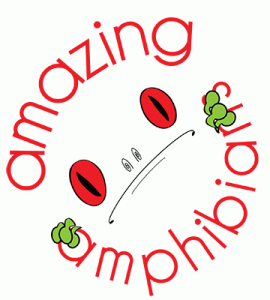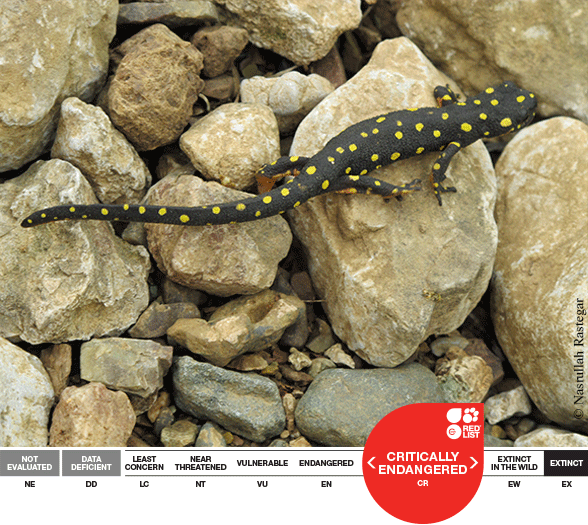 The Kurdistan Newt, or Neurergus microspilotus, like many salamander species, is known for its breeding behavior where the male entices the female by waving his tail in front of her and then leading her to pick up his sperm packet, called a spermatophore, which he lays in her path. It was previously thought that this newt is restricted to the Avraman Mountains of the Iraq-Iran-Turkey border. However, based on extensive fieldwork in central and northern regions of the Zagros Mountains in Kermanshah and Kurdistan Provinces, the Kurdistan Newt has been found in at least nine severely fragmented streams, with almost no movement of the species among the streams. The Kurdistan Newt is currently listed as ‘Critically Endangered’ on the IUCN Redlist of Threatened SpeciesTM.
The Kurdistan Newt, or Neurergus microspilotus, like many salamander species, is known for its breeding behavior where the male entices the female by waving his tail in front of her and then leading her to pick up his sperm packet, called a spermatophore, which he lays in her path. It was previously thought that this newt is restricted to the Avraman Mountains of the Iraq-Iran-Turkey border. However, based on extensive fieldwork in central and northern regions of the Zagros Mountains in Kermanshah and Kurdistan Provinces, the Kurdistan Newt has been found in at least nine severely fragmented streams, with almost no movement of the species among the streams. The Kurdistan Newt is currently listed as ‘Critically Endangered’ on the IUCN Redlist of Threatened SpeciesTM.
 |
A major threat to this species has been a series of severe droughts affecting its breeding habitat, which has led to the extirpation of some populations. Stream water is being extracted by nearby orchards and wheat fields, and some water contamination near villages is causing decline in populations. A recently increasing threat has been the involvement of this species in the illegal pet trade, especially in pet shops in Iran.
The species occurs in the narrow valleys of the Zagrosian Oak Forest, which is generally protected by national legislation in Iran, but requires better enforcement. Unfortunately, the illegal exporting of the species for the pet trade is growing, and also needs to be better regulated. The Kurdistan Newt has been successfully bred in captivity, which might play a bigger role in the future conservation of the species. Since 2008 a group of herpetologists from Razi University in Kermanshah, Iran have established several small groups of the Kurdistan Newt in captivity at the University and began a captive breeding program, which have lead to some publications. Studies about the natural history, conservation, and various other aspects of biology of this amazing newt are ongoing.
Submit your observations of this species to iNaturalist and they will appear on this map. Learn more about this species on Amphibiaweb.
More Amazing Amphibians here.
Produced in partnership with:
Senior Partners |
|||
 |
 |
 |
|
 |
|||
Focal Partners |
|
 |
|
Affiliates |
|||
 |
 |
||
 |
|||
How to become an Amazing Amphibians partner:
Outlined below are the roles and responsibilities for the 4 different levels of involvement for potential partners. If your organization would like to be a part of the Amazing Amphibians program in either of these capacities please email amazing@amphibians.org.
Senior Partner – These partners will help with multiple aspects of the program, help facilitate the completion of several species profiles, publicize each Amazing Amphibian and will likely have a landing page for the program on their website. This level of partner will be leading in using their communication channels to gather additional information for the program such as images and data points for iNaturalist.
Strategic Partner – These partners will play an active role in creating species profiles, submitting at least three species profiles per year and actively use their social network to publicize each Amazing Amphibian. This level of partner will be active in using their communication channels to gather additional information for the program such as images and data points for iNaturalist.
Focal Partner – Partners tend to be active in a limited geographic area. This partner will submit at least one regional species profile per year and use their social network to publicize each Amazing Amphibian. This level of partner will be involved in using their communication channels to gather additional information at a regional level for the program such as images and data points for iNaturalist.
Affiliate – These partners are interested in promoting the program but might not be in a position to provide profiles. These partners will publicize each Amazing Amphibian through the social media outlets.







